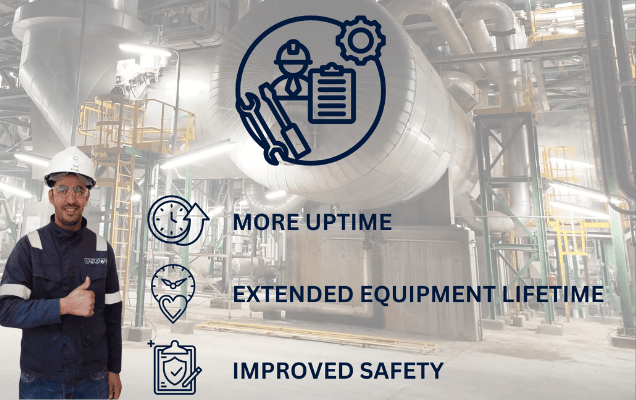
Preventive Maintenance at SSE MULTINATIONAL is a proactive service aimed at maintaining the optimal performance and longevity of industrial systems and equipment. This service involves scheduled inspections, servicing, and repairs to identify and address potential issues before they lead to equipment failure. It includes routine checks, lubrication, calibration, and replacement of worn parts to reduce downtime, improve safety, and enhance operational efficiency. By implementing preventive maintenance, SSE MULTINATIONAL helps clients minimize unexpected breakdowns and extend the life of their equipment, ensuring consistent and reliable performance in industrial operations.
At SSE Multinational, we believe that clear communication and expertise are key to successful project outcomes. That’s why we’re here to address any questions you may have—whether about our commissioning services, project strategies, or customized solutions. Our team of industry experts is dedicated to providing the insights and guidance you need every step of the way, ensuring confidence and clarity throughout your project journey. Reach out, and let us cover your questions with the answers you deserve.
Preventive maintenance is a proactive maintenance strategy that involves regularly scheduled inspections, cleaning, lubrication, calibration, and the replacement of worn-out parts to ensure the equipment continues to operate efficiently and to prevent unexpected breakdowns.
Preventive maintenance is important because it helps to reduce equipment failures, prolong the lifespan of machinery, improve safety, reduce unplanned downtime, and ensure efficient and reliable operations.
The frequency of preventive maintenance depends on the type of equipment, manufacturer recommendations, operating conditions, and usage patterns. Common schedules are weekly, monthly, quarterly, or annually, depending on the equipment’s criticality and complexity.
Key tasks include:
Preventive maintenance identifies and resolves potential issues before they cause major failures. By regularly maintaining equipment, it reduces the chances of unexpected breakdowns and ensures the machinery operates efficiently, leading to less unplanned downtime.
Preventive maintenance is planned and performed regularly to prevent failures, while corrective maintenance is reactive and performed after equipment has failed or malfunctioned. Preventive maintenance is proactive, while corrective maintenance is reactive.
Yes, by regularly maintaining equipment, replacing worn-out parts, and ensuring optimal performance, preventive maintenance can significantly extend the lifespan of machinery and reduce the likelihood of early failure.
Common tasks include cleaning, lubricating moving parts, inspecting electrical connections, checking fluid levels, testing control systems, replacing filters, adjusting pressures, and verifying equipment alignment.
Preventive maintenance helps ensure that safety systems (e.g., emergency shutdown systems, alarms, and fire suppression) are functioning properly. Regular maintenance of these systems helps prevent accidents and ensure a safe working environment.
Lubrication reduces friction and wear on moving parts, which helps to prevent overheating, breakdowns, and part failures. Regular lubrication ensures smoother operation and extends the life of critical components.
Preventive maintenance can be tracked using maintenance management software or a manual logbook. This helps ensure that maintenance tasks are completed on time, and any issues identified are addressed promptly.
A preventive maintenance schedule ensures that maintenance tasks are performed on time, reducing the risk of overlooked inspections or repairs. It also helps improve equipment reliability, reduce costs, and increase overall system performance.
All types of industrial, mechanical, electrical, and HVAC equipment require preventive maintenance. This includes pumps, motors, compressors, conveyors, HVAC systems, and instrumentation.
By preventing unexpected breakdowns and prolonging the life of equipment, preventive maintenance reduces repair costs, lowers the need for expensive emergency repairs, minimizes downtime, and increases overall equipment efficiency, leading to cost savings.
Challenges include ensuring that maintenance schedules are followed consistently, finding the right balance of maintenance frequency, dealing with parts availability, and ensuring adequate training for maintenance personnel to perform the tasks correctly.
Preventive maintenance ensures that equipment runs at optimal levels by fixing small issues before they escalate, adjusting settings, and replacing parts. This leads to improved energy efficiency, smoother operation, and better overall system performance.
The schedule is typically based on manufacturer recommendations, equipment usage, operational environment, and historical performance. It’s important to tailor the schedule to the specific needs and criticality of the equipment.
Yes, preventive maintenance is designed to identify and fix small issues before they lead to significant equipment failure or costly breakdowns, thus avoiding major operational disruptions.
Preventive maintenance contributes to sustainability by improving the efficiency of equipment, reducing energy consumption, minimizing waste, and extending the life of assets, which reduces the need for replacements and lowers environmental impact.
Yes, many companies choose to outsource preventive maintenance to specialized service providers like SSE MULTINATIONAL who have the expertise, tools, and experience to carry out maintenance tasks efficiently, ensuring equipment reliability and performance.
